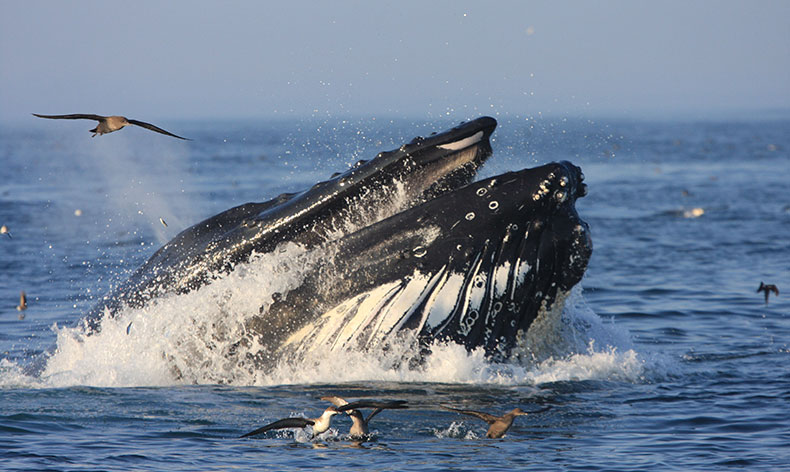
Pressures on Stellwagen Bank Sanctuary
Numerous human activities and natural events and processes affect the condition of natural and archaeological resources in marine sanctuaries. This section describes the nature and extent of the most prominent pressures on the Stellwagen Bank sanctuary.
Shipping
Stellwagen Bank sits at the mouth of Massachusetts Bay and is open to vessel traffic traveling to and from the Port of Boston, which is one of the most modern and efficient container ports in the U.S. The port handles more than 1.3 million tons of general cargo, 1.5 million tons of non-fuel bulk cargo and 12.8 million tons of bulk fuel cargos yearly. The designated traffic separation scheme for Boston passes in a roughly east-west direction through the sanctuary. These lanes are used for numerous types of domestic and foreign-flagged vessels, including container ships (some with hazardous materials), liquefied natural gas and oil tankers and barges, and an increasing number of cruise liners. While many vessels remain in the designated travel lanes, use of these lanes is not mandatory and vessel traffic occurs throughout the sanctuary. Stressors from these vessels include noise disturbance of animals, strikes to whales, pollutant discharges, and introduction of invasive species.
Outfall Discharges & Dumping Sites
The Massachusetts Water Resources Authority (MWRA) outfall discharges on the order of 350 million gallons per day of treated secondary effluent 12 miles west of the sanctuary. Potential stressors from the outfall and other point and non-point sources of pollution include eutrophication, discharge of toxic chemicals, and discharge of agents that alter biological processes (e.g., endocrine disrupters). The Massachusetts Bay Disposal Site for clean dredge material is located in Stellwagen Basin adjacent to the sanctuary's western boundary. Materials deemed free of hazardous materials by the U.S. Army Corps of Engineers and the U.S. Environmental Protection Agency may be dumped at this site. Known hazardous and radioactive materials were dumped in and around this site in the 1940s and 1950s (Wiley et al. 1992). Given the proximity of the dumpsite to the sanctuary there is concern that these dumped materials have impacted sanctuary habitats and that barrels with toxic materials are leaking.
A fiber optic cable was laid across the northern part of the sanctuary under federal permit in 2000. This cable provides a direct link between North America and the Republic of Ireland. The cable is designed for a life expectancy of 25 years and is buried at an average depth of approximately 1.5 meters into the seafloor. The major impact is habitat disturbance from the cable laying (and burial) process, and from potential repair or removal operations.
Liquefied Natural Gas Deepwater Port
It is likely that a deepwater port for the off-loading of liquid natural gas will be installed in the near future, approximately two miles west of the western boundary of the sanctuary. The development of such a port, along with the existing MWRA deep-water sewage outfall and the Massachusetts Bay Disposal Site creates a de facto industrial zone adjacent to the sanctuary. Concerns in this area include contamination from discharges, and in the case of proposed liquid natural gas ports, increased vessel traffic and noise, displaced commercial fishing and whale watching activities, and impacts to the sanctuary's scenic views.Noise
The level of noise pollution in the oceans and in the Stellwagen Bank sanctuary has increased dramatically during the last 50 years. The primary source of low frequency ocean noise is commercial shipping (NRC 2003). Many marine mammals respond to noise by altering their breathing rates, spending more time underwater before coming up for air, changing the depths or speeds of their dives, shielding their young, changing their song note durations, and swimming away from the affected area (Richardson et al. 1995). Noise pollution may cause marine mammals and other organisms to acquire temporary or permanent hearing loss. The disorientation and hearing loss may account for cases in which ships collide with marine mammals that are apparently unaware of the approaching vessel. Most strikes occur in coastal waters on the continental shelf where large marine mammals concentrate to feed.Commercial Fishing
Fishing with mobile gear such as trawls, scallop and clam dredges, together with fixed gear such as bottom-tending gill nets and lobster pots, occurs extensively throughout the sanctuary.
Commercial Whale Watching
Currently, there are 15 commercial whale watch companies visiting the Stellwagen Bank sanctuary operating a total of 24 boats that make single and sometimes multiple trips daily from April through October.

